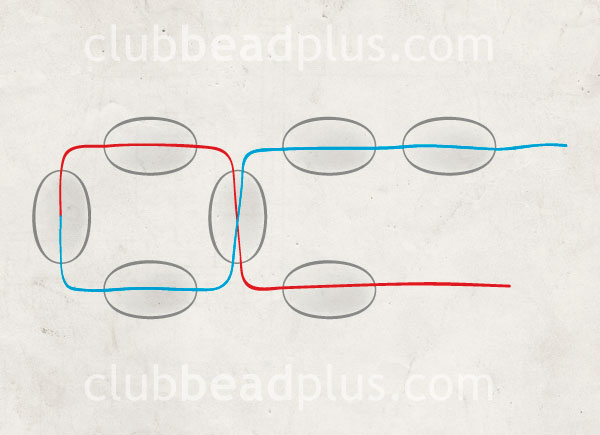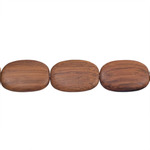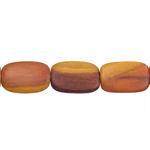Beader’s dictionary
W
WATCH (See products)
A watch is a time measuring tool that is worn around the wrist, hanging from a pocket, or as a broach, a charm, a key chain, as a necklace pendant, as a ring etc. Watch dials are available in a multiplicity of colors, shapes and styles and they be added to a piece of jewelry. Some watch dials have loops, other are perforated and allow the insertion of strings are fabrics bands.
A little bit of history: Although the origin of the watch throughout time is a tad uncertain, it is a fact that François I (1494-1547), king of France, already had two and that Elisabeth I (1533-1603) queen of England had a ring watch.
WEAVING
Weaving is achieved by the action of linking together one or two strings, with or without beads. In terms of fashion jewelry, when referring to weaving, it usually implies a weaving with beads, often with seed pearls. There are several kinds and stitches that can be used when weaving. Some more popular than others.
Brick stitch
The brick stitch starts after having made a row of ladder stitches as a base. For a second row, after having strung a bead on the string, thread it between the 2 beads of the ladder stitch (or the last row that was made) to make a loop around the string of the previous row, then thread it through the bead that was just strung. The beads of the brick stitch link themselves to each other by the string that makes a loop around the string from the previous row, whereas in the peyote stitch, they are linked by a row from the previous row. 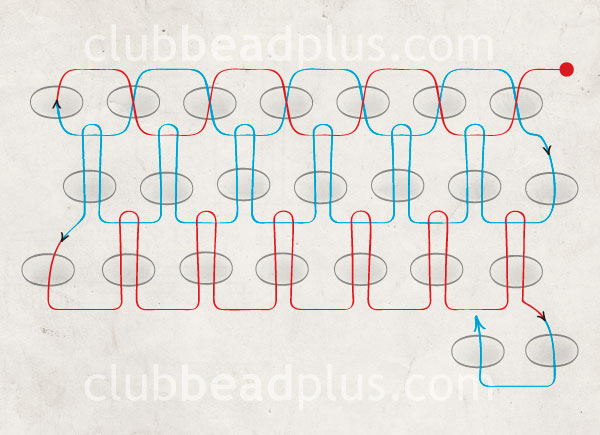

Herringbone
Of south african tradition, it is also called Ndebele, derived of the name of the tribe that discovered it. The herringbone stitch looks like a herringbone (“V” shaped) when it is achieved with a certain amount of beads per row. For a straight weaving, choose an odd number of beads.
The herringbone stitch starts after having made a row of ladder stitches as a base. Simply string 2 beads, put the needle through the 2nd bead of the ladder stitch and exit through the 3rd bead. String 2 new beads and repeat the last step, while threading the string between the last row and the new one just added. The pattern can be discerned after several rows (for a weaving with an even number of beads).


Lader stitch
The ladder stitch is a basic stitch for many others such as the herringbone and the brick stitches.
Simply string 2 beads successively on a string and pass it through the first bead again, clockwise, then through the 2nd bead. position the beads side by side so that their holes are perpendicular. Pass the string through both beads again.
String a third bead and pass it through the second bead counterclockwise. String it through the 3rd bead while keeping the same gyratory sense. Keep adding beads while alternately changing the rotation sense until you get to the number of beads you want. You must obtain a tight straight line. It is strongly suggested to pass the beads in a zig zag pattern all the way back to the beginning to strengthen the ladder stitch.


Peyote stitch
The peyote stitch can be made flat or in a tubular fashion. Peyote stitching is a native technique, the tubular peyote stitch was used for circular objects such as canteens. Flat or tubular, the various rows are imbricated one in the other. For example, for a first row of 6 beads, only string 3 beads in the second row and pass it through the 3 beads from the previous row again, simply alternate; string a bead then string again a bead from the previous row, repeat it until the desired length.
The tubular peyote stitch is obtained the same way, except that only one long row is weaved in a spiral instead of weaving different rows back and forth.
The peyote stitch is one the most used stitch when weaving fashion jewelry.


Russian spiral stitch
This stitch allows for the insertion of different types and sizes of seed beads, notably tubular seed beads and the result has a similar aspect to that of a spiral or a twist.
To make the first row, simply string all the chosen beads in the desired order. Then thread the string through the first three beads or make a knot to join the first and last bead and thus form a circle. For the second row, three beads must be strung and then threaded in a bead from the previous row. To determine in which bead to string through, it is important to always skip two beads and thread through the third. Keep weaving as such in spirals (tube).


Square stitch
This stitch is very similar to the one used when weaving using a loom, the difference being that beads are weave one by one whereas on a loom it is done by row. In this type of weaving, the beads are lined to each other and form square angles, like a square.
To achieve the square stitch, simply string the number of beads wanted to make the first row. For the second row, a bead is strung then the last bead at the bottom is looped in the previous row and it goes on. Beads are thus straightly lined, one directly above the others.
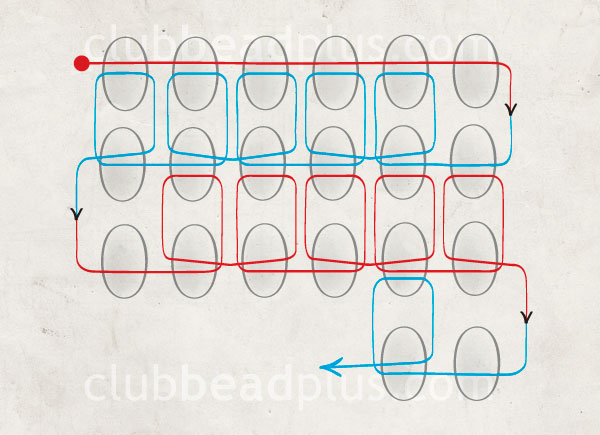

Triangle weave
The triangle weave, as its name indicates, consists of weaving 3 beads (or a series of beads) in a triangle. The juxtaposition of the triangles will shape the weaving.
To make it, string 3 beads on the string, then fold it back as a loop in the last bead threaded from the first triangle and so on. Then the string must be weaved in and out through the triangle that was just made, to make another one to form a row of triangles.
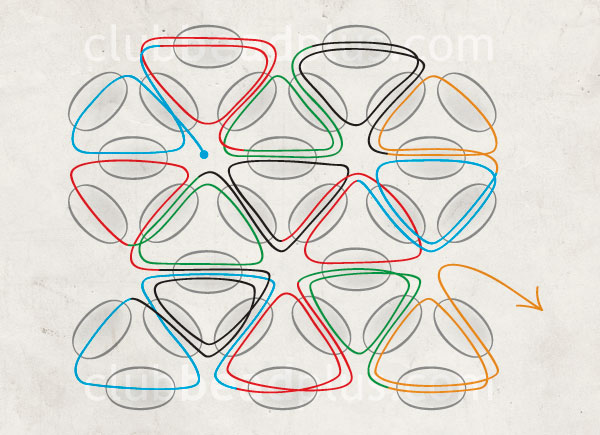

WIRE ROUNDER (See products)
Tool that has a concave edge that rounds or softens the edge of a metal wire. Simply place the edge of the wire in the cup bur and turn the tool while maintaining pressure against the wire to file its end. It is very useful to make crafty earring hooks. Use it with metal wires made of copper, aluminum or silver of a caliber equal or lower than 16.
WOOD (See products)
An organic and natural material, wood can be found locally or imported for its exoticism. Some are common species (pine, birch, etc.), others are more rare or exotic (Sebucao, Greywood, Nangka, Kamagong, Bayong, palm, coconut, hazelnut, etc.).
Bayong (See products)
This orange-colored hardwood comes from a region of the Cebu island, in the Philippines. It is also found in Malaysia and Indonesia.
HAZELS (See products)
Hazels are known to relieve or prevent: heartburn, gastric reflux, dental growth, skin problems (psoriasis, acne, eczema), osteoarthritis arthritis, constipation, migraines, tooth decay, discomfort related to a surplus of acidity, etc.
Hazel wood beads are produced by hand in Quebec and are sold to be incorporated into creations.
The life of a necklace depends on your body's acidity. In general, it lasts six months to a year. When the wood has blackened at the ends, it is a sign that you need to make a new necklace or bracelet to take advantage of its benefits!
Kamagong (See products)
The Kamagong, also called Mabolo, is a fruit tree only found in the Philippines. The wood of this tree, whose color ranges from a brown caramel to the brown of a very dark chocolate, is extremely dense and hard. It belongs to the same family as ebony. The tree is cultivated for its tasty fruits and its particular wood. This wood is often used for the manufacture of weapons, both for aesthetics and for its resilience. It is a tree species protected by law. The Philippines regulate and now control its exploitation and export.
Palm wood (See products)
Palm wood is a very hard sort of wood used in construction and i is often associated with coconut and date palm. It is a wood whose use is fairly recent and has been developed to counter the usage of protected species from the rainforest.
The palm wood is mainly provided by coconut plantations, but it can also come from plantations of date palms. In the tropics, gigantic coconut plantations were established in the first half of the 20th century for coconut cultivation.
These trees produce fruits for about 70 years. Past that, they are considered unfit for production. Each year, thousands of trees are replaced by younger trees and suitable for nut production. The rejected trees started to be used for timber only in the past decades.
Palm wood is a wood whose density may vary depending of its color. The dark brown wood is usually very dense. The brown wood has a medium density, and the pale, golden brown wood has a lower density. One variety is Patikan wood, which is light brown with dark brown stripes.
Sebucao (See products)
Exotic hardwood from the Philippines with natural orange hues. Over time, when it is worn, it absorbs body oils and turns to a darker color.
WOOD STICK (See products)
Stir sticks are used to mix casting resin. There are sticks intended to this specific purpose and they have a flat tip (cut at a right angle) to allow them to access the bottom of the container and to scrape the sides. This allows for the mixture to be stirred until a homogenous substance is obtained.
WRAPPING
Wrapping is a common technic used in the fashion jewelry making industry. This technic aims to wrap a bead in metal strings (copper, aluminum, brass, silver sterling, stainless steel, etc.) to allow it to be decorated or added to a jewelry piece. The term wrapping often refers to metal strings but the bead can also be wrapped in another material.
















